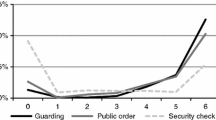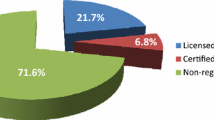Abstract
Licensing requirements for US private security firms and guards differ substantially from state to state. State regulatory institutions for this industry also vary considerably. Some states have specialized regulatory boards with industry personnel (guards, firm owners) and/or public police as board members, while others rely on non-specialized regulators such as Departments of Commerce, State, Professional Regulation, or Consumer Affairs. These cross-state variations in licensing requirements and regulatory institutions provide an opportunity to explore relationships between the two. Private security regulation is of particular interest in this context because previous empirical research implies that allocating more resources to private security reduces crime, and that relatively stringent licensing requirements limit entry, thereby increasing crime. A panel of 1991–2010 state data is employed to see if particular regulatory institutions are associated with particular licensing requirements. Empirical results suggest that requirements for entry into this market tend to be relatively strict when active private security personnel are in control of licensing, and that different patterns of regulation generally apply when police or non-specialized agencies control licensing. Therefore, both public-interest and private-interest explanations for the observed relationships between the structure of regulatory institutions and resulting licensing requirements are discussed.
Similar content being viewed by others
Notes
Some municipalities have additional requirements.
Several models of bureaucracy (Tullock 1965; Niskanen 1975; Breton and Wintrobe 1982) assume that significant principal-agent problems (or agency “slack”) allow bureaucrats to pursue their own narrow objectives. Other supply-side models consider issues like corruption (Benson and McChesney 2004) or agenda control (Romer and Rosenthal 1978; McChesney 1987).
Friedman (1962) contends, however, that third-party certification could solve the asymmetric-information problems without creating a monopolistic environment through licensing.
Multiple interest groups may form and effectively influence regulation, so all may gain something (Peltzman 1976).
Governments increasingly are contracting with private security firms for various functions that police departments historically have performed, such as guarding courthouses, transporting prisoners, parking control, and even patrolling (Benson 1998, 2014), so police may see private security as a threatening their jobs.
A clearance rate is the portion of reported crimes, either in aggregate or for a specific crime category, resolved by arrest during a specified time period. If private security helps police clear cases by sharing information and enhancing police response times, and/or succeeds in catching criminals, clearance rates may increase, so private security guards would provide a complement to public police for this objective. Presumably, an increase in clearance rates would be in the public interest. On the other hand, response times and clearance rates are measures on which police departments often are evaluated during budget negotiations, so these complementarities could produce private-interest objectives.
In some states proprietary (in house) security services are not subject to these requirements, but they apply to all firms specializing in the provision of security.
One obvious requirement that is omitted is licensing fees. Regulatory requirements establishing a lower bound on entry are employed in the following analysis, but determining the licensing fee consistent with the lowest bound was not possible for states with particularly complex fee structures. The fees in some states increase with the number of employees; in others, fees vary for different licensure classifications. Similarly, fees for conducting background checks explicitly are added in some states but not in others, even though such checks are required.
This variable is the combined dollar value of liability and property insurance one must prove to have obtained prior to applying for a license, and/or the amount of money a firm has to post as a bond. The sum of the two is used if states required both. If the state requires one or the other, the minimum of the two is recorded.
Maryland’s licensing requirements apply to firms with five or more employees. Since most of the firms in the state have more than five employees, these data are used, assuming that, in practice, this is the lower bound for entry.
Employing armed guards often requires a different (more stringent) level of licensing, but a substantial majority of private security personnel are not armed (Graduate Institute of International Development Studies 2011, pp. 111–116).
In some states, industry personnel on commissions or boards are members of private security trade organizations such as the American Society of Industrial Security (ASIS) and National Association of Security Companies (NASCO).
A few states have advisory boards that recommend regulatory changes, but the legislature or some other department or commission must approve the changes before they can go into effect. These advisory boards are included as regulatory boards in the dataset. Some boards solely are administrative, however, in that they only review/approve licensing applications. Purely administrative boards are not identified herein as regulatory.
These regulatory agencies include the Department of Commerce, Department of State, Department of Professional Regulation, Attorney General, Department of Health, Department of Consumer Affairs and similar agencies.
The Republican Party vote share is collected for each presidential election and interpolated linearly for the years between elections. These data were collected from Dave Leip’s Atlas of U.S. Presidential Elections (http://uselectionatlas.org/).
A probit model was attempted with correlated random effects to control for the individual state level fixed effects, but, because of severe multicollinearity, this estimation did not converge.
In light of this concern, a stripped down model with the natural log of population as the only variable in X it is presented, and then the other listed variables are added as a robustness check.
States with some type of grandfather clause regarding previously licensed firms include but may not be limited to Florida, Hawaii, Illinois, Maine, Nevada, Rhode Island, Tennessee, and Utah. Regulations must change during the data period employed here in order to observe whether or not grandfathering is granted, and so we may have missed states that implemented new requirements before or after the data period. Also, implicit grandfathering, when renewal requirements are less strict than entry requirements, often cannot be determined by examining the statutes and codes dealing with initial licensing requirements.
Among the states listed in footnote 20 that clearly have in place some type of grandfather clause, Hawaii, Illinois, Nevada, and Utah all have industry members involved in setting the regulations. Illinois and Nevada have industry-controlled boards without any police representation.
See footnote 8.
Additional welfare costs arise as crime rises. Tullock (1967) explains that theft is analytically equivalent to the pursuit of transfers (rents) through the political process. Resources used to commit thefts have opportunity costs too, in that they could produce additional wealth rather than being wasted in the competition for wealth transfers. Therefore, the relatively high level of crime associated with reduced private security provision means that accompanying Tullock costs are relatively high.
References
Ayres, I., & Levitt, S. (1998). Measuring positive externalities form unobservable victim precaution: an empirical analysis of Lojack. Quarterly Journal of Economics, 113, 43–77.
Becker, G. (1983). A theory of competition among pressure groups for political influence. Quarterly Journal of Economics, 68, 371–400.
Benson, B. (1995). Understanding bureaucratic behavior: Implications from the public choice literature. Journal of Public Finance and Public Choice, 8, 89–117.
Benson, B. (1998). To serve and protect: privatization and community in criminal justice. New York: NYU Press.
Benson, B. (2002). Regulatory disequilibrium and inefficiency: the case of interstate trucking. Review of Austrian Economics, 15(2), 229–255.
Benson, B. (2005). Regulation, more regulation, partial deregulation, and reregulation: The disequilibrating nature of a rent-seeking society. In P. Kurrild-Klitgaard (Ed.), The dynamics of intervention: Regulation and redistribution in the mixed economy; Advances in Austrian economics (Vol. 8, pp. 105–143). Bingley: Emerald Group Publishing Limited.
Benson, B. (2014). Let’s focus on victim justice, not criminal justice. Independent Review: A Journal of Political Economy, 19(2), 209–238.
Benson, B., & Mast, B. (2001). Privately produced general deterrence. Journal of Law and Economics, 44(2), 725–746.
Benson, B., & McChesney, F. (2004). Corruption. In E. Colombatto (Ed.), Companion to the economics of property rights (pp. 328–352). London: Edward Elgar.
Benson, B., & Meehan, B. (2014). Does private security affect the level of crime? A test using state regulations as instruments. Florida State University Working Paper.
Breton, A., & Wintrobe, R. (1982). The logic of bureaucratic control. Cambridge: Cambridge University Press.
Carpenter, D, I. I., Knepper, L., Erickson, A., & Ross, J. (2012). License to work: A national study of burdens from occupational licensing. Arlington, VA: Institute for Justice.
Che, Y. K. (1995). Revolving doors and the optimal tolerance for agency collusion. Rand Journal of Economics, 26(3), 378–397.
Cohen, J. (1986). The dynamics of the ‘revolving door’ on the FCC. American Journal of Political Science, 30(4), 689–708.
Dal Bo, E. (2006). Regulatory capture: A review. Oxford Review of Economic Policy, 22(2), 203–225.
Faith, R., Leavens, D., & Tollison, R. (1982). Antitrust pork barrel. Journal of Law and Economics, 25, 329–342.
Friedman, M. (1962). Capitalism and freedom. Chicago: University of Chicago Press.
Gormley, W. (1979). A test of the revolving door hypothesis at the FCC. American Journal of Political Science, 23(4), 665–683.
Graduate Institute of International Development Studies. (2011). Small arms survey: States of security. Graduate Institute of International Development Studies.
Johnson, R., & Libecap, G. (1994). The federal civil service system and the problem of bureaucracy. Chicago: University of Chicago Press.
Kim, I., & Cho, J. (2001). Jobs in the bureaucratic afterlife: A corruption-facilitating mechanism associated with law enforcement. Southern Economic Journal, 68(2), 330–348.
Kliener, M., & Krueger, A. (2013). Analyzing the extent and influence of occupational licensing on the labor market. Journal of Labor Economics, 31(2), S173–S202.
Law, M., & Kim, S. (2005). Specialization and regulation: The rise of professionals and the emergence of occupational licensing regulation. Journal of Economic History, 65(3), 723–756.
Leland, H. (1979). Quacks, lemons, and licensing: A theory of minimum quality standards. Journal of Political Economy, 87(6), 1328–1346.
MacDonald, J., Klick, J., & Grunwald, B. (2012). The effect of privately provided police services on crime. University of Pennsylvania, Institute for Law & Economics Research Paper No. 12–36.
McChesney, F. (1987). Rent seeking and rent creation in the economic theory of regulation. Journal of Legal Studies, 16(1), 101–118.
Niskanen, W. (1975). Bureaucrats and politicians. Journal of Law and Economics, 18, 617–643.
Peltzman, S. (1976). Toward a more general theory of regulation. Journal of Law and Economics, 19, 211–240.
Pigou, A. (1932). The economics of welfare. London: Macmillan and Co.
Posner, R. (1974). Theories of economic regulation. Bell Journal of Economics and Management Science, 5, 335–358.
Romer, T., & Rosenthal, H. (1978). Political resource allocation, controlled agendas, and the status quo. Public Choice, 33, 27–43.
Stigler, G. (1971). The theory of economic regulation. Bell Journal of Economics and Management Science, 3, 3–18.
Tollison, R. (1982). Rent seeking: A survey. Kyklos, 35, 575–602.
Tullock, G. (1965). The politics of bureaucracy. Washington, DC: Public Affairs Press.
Tullock, G. (1967). The welfare costs of tariffs, monopolies, and theft. Western Economic Journal, 5, 224–232.
Weingast, B., & Moran, M. (1983). Bureaucratic discretion or Congressional control? Regulatory policy-making by the Federal Trade Commission. Journal of Political Economy, 91, 765–800.
Zedlewski, E. (1992). Private security and controlling crime. In G. W. Bowman, S. Hakim, & P. Seidenstat, Privatizing the United States justice system: police adjudication, and corrections services from the private sector (pp. 42–55). Jefferson, NC: McFarland & Company.
Zimmerman, P. (2014). The deterrence of crime through private security efforts: theory and evidence. International Review of Law and Economics, 37, 66–75.
Acknowledgments
The authors would like to thank Anastasia Semykina, Pete Leeson, Sam Staley, Bill Shughart, Alice Crisp, participants in the DeVoe Moore Center Workshop at Florida State University, and participants in the Mercatus Center Adam Smith Fellowship program for useful comments.
Author information
Authors and Affiliations
Corresponding author
Rights and permissions
About this article
Cite this article
Meehan, B., Benson, B.L. The occupations of regulators influence occupational regulation: evidence from the US private security industry. Public Choice 162, 97–117 (2015). https://doi.org/10.1007/s11127-014-0203-1
Received:
Accepted:
Published:
Issue Date:
DOI: https://doi.org/10.1007/s11127-014-0203-1




